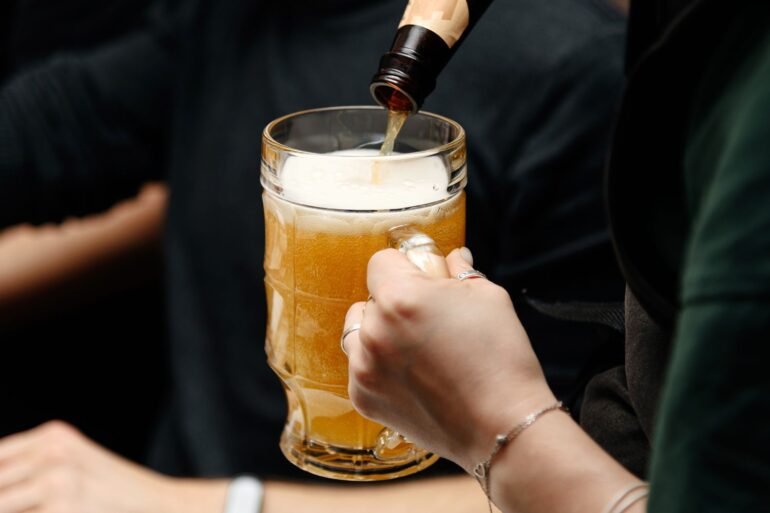:max_bytes(150000):strip_icc():format(jpeg)/The-Fastest-Way-to-Ruin-a-Beer-FT-DGTL1025-26f67b7364f74a1ba7a02f978a1adf6d.jpg)
Serving beer in a frosted glass is a familiar gesture in many bars and restaurants, often regarded by thirsty patrons as a mark of thoughtful service and hospitality. The image of a glass shimmering with ice, promising instant refreshment and unparalleled enjoyment, became ingrained in American beer culture as a symbol of status, refinement, and best practice.
But for those who cherish quality over outdated optics, the practice is not only unnecessary — it can actually diminish the experience of drinking a well-made beer.
Don’t believe it? Trust the science, or try a side-by-side taste test and thank us later.
How did we get here, and why are frosted glasses a thing?
In the mid-20th century, mass-market beers dominated the scene. Light lagers were largely designed for maximum refreshment rather than depth of flavor or complexity of aroma. These were beers that were easy to enjoy, meant to be consumed cold and quickly, without much contemplation.
As establishments sought to reinforce the allure of icy-cold pour, the frosted glass became standard, its frosty appearance a visual promise of coolness and refreshment. And during warm summer months or in smoky taverns, the chilled glass added appeal, making macro lagers even more palatable by masking imperfections and sharpening their crisp, quaffable qualities.
But the frosted glass doesn’t serve all brews equally.
How frosted glasses ruin good beer
While frosted glasses may suit lighter macro brews such as Budweiser, Miller, Coors, or Pabst Blue Ribbon — helping them stay cold and go down easily — for beers with more complexity than just being fizzy and yellow, the frosted effects can be surprisingly detrimental.
The rise of the American craft-brewing scene, with its more varied and nuanced beer styles, exposed the shortcomings of frosted-glass service. Beer is an intricate combination of flavors, aromas, and textures, each carefully considered to provide a unique and layered experience. A frosted glass, unfortunately, interferes with much of that craft.
The ideal serving temperature for beer ranges from 35ºF to 60ºF, depending on the style. Excessive cold suppresses the volatile compounds that give beer its aroma. These scents can include anything from floral notes of hops to fruity esters or spicy undertones imparted by yeast. Instead of greeting the senses with a vibrant bouquet, beer served in a frosted glass seems muted and subdued.
Ultimately, if the beer is being served from a properly refrigerated keg or bottle, why would you need to chill your glass at all?
Temperature also plays a crucial role in the perception of flavor. When beer is served too cold, its complexity flattens, leaving only a generic sense of chill. Those hints of caramel in your brown ale, sweet baking spice in your seasonal brew, or citrus snap in your favorite IPA? All lost to frost.
Mouthfeel suffers, too. Ice crystals on a frozen glass act as nucleation points, causing carbonation to rapidly escape and create a overly foamy head in the glass instead. Not only does that result in a frothy mess that’s tough to drink through, but also leaves the beer flat by the time you’re halfway through.
There’s also the matter of hygiene. Glasses kept in freezers can absorb odors or accumulate residues, becoming dirty with mystery molecules floating around the shared freezer space, or even detergents or cleansers if chilled directly from the washer while damp. All these possibilities can introduce off-flavors that further compromise the beer’s intended profile.
Ultimately, if the beer is being served from a properly refrigerated keg or bottle, why would you need to chill your glass at all? You wouldn’t do it for wine, so why single beer out?
That’s right. You shouldn’t.
When, if ever, should you use a frosted glass?
There are rare occasions when a frosted glass may be acceptable, but these are typically for ultra-light, mass-market lagers or low-alcohol beers designed to refresh and without much thought or nuance.
For these selections, the loss in flavor or aroma is negligible, and the chilled glass may indeed add a pleasurable coolness to something already designed to be innocuous.
But for any beer with craftsmanship, character, or aromatic depth, a clean, room-temperature glass is best. Most craft beers reach their greatest expression at 40°F to 55°F, where both aroma and flavor flourish.
Take the time to enjoy a great beer’s subtleties. It’s a small act of respect — for the brewer, the beer, and your own experience. And if you’d like it colder, just chill the beer longer. Skip the frosted glass.
Lauren Buzzeo
2025-10-16 14:29:00

